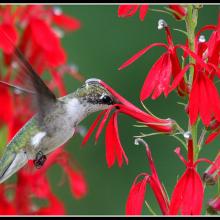

Join BirdNote tomorrow, November 30th!
Illustrator David Sibley and actor H. Jon Benjamin will face off in the bird illustration battle of the century during BirdNote's Year-end Celebration and Auction!
Ruby-throated Hummingbirds are the only hummingbirds that nest in the Eastern states. Most Ruby-throats spend the winter in Central America. By March, some males are already returning to the Southeast. But it's well into April before they reach the northern states. Female hummingbirds arrive a couple weeks later. What hummingbird might you see in your region? Check out hummingbirds.net. Put up a feeder and attract one to your yard.
BirdNote®
Ruby-throated Hummingbirds Are on the Way
Written by Bob Sundstrom
This is BirdNote.
[Rapid squeaky chips and wing hum of male Ruby-throated Hummingbird]
It’s late April in the Northeast. You’ve just stepped out for a breath of spring air and — [Rapid squeaky chips and a very brief bit of wing hum of male Ruby-throated Hummingbird] — Hey, what was that!? A tiny bird just whizzed by like a bullet. There it is, over by those scarlet flowers, hovering – it’s a hummingbird. It must be a Ruby-throated Hummingbird, the only hummingbird that nests in the Eastern states. No wonder it buzzed you – You’re wearing a red baseball cap! Must have thought you were a really prize flower.
Most Ruby-throated Hummingbirds spend the winter in Central America. By March, some males are already returning to the Southeast. But it’s well into April before they reach the northern states. Female hummingbirds arrive a couple weeks later, after the males have staked out breeding territories. Males greet females with a remarkable aerial performance, flying back and forth in a perfect arc, like a pendulum suspended on an invisible wire – and accompanied by buzzing wings and cricket-like chirps [Display sounds of male].
So fill up the hummingbird feeder, put on a red hat or jacket, and listen for a hummingbird coming your way. [Rapid squeaky chips and wing hum of male Ruby-throated Hummingbird]
Learn what hummingbird might visit your yard, when you come to our website, BirdNote.org. I’m Mary McCann.
###
Bird sounds provided by Martyn Stewart, NatureSound.
BirdNote's theme music was composed and played by Nancy Rumbel and produced by John Kessler.
Producer: John Kessler
Executive Producer: Chris Peterson
© 2015 Tune In to Nature.org April 2015 Narrator: Mary McCann
ID# RTHU-02-2009-04-30-MM-






